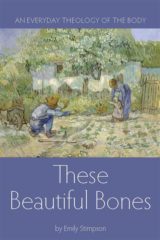By Emily Stimpson Chapman
Emily Stimpson Chapman is the award-winning author of several books, including These Beautiful Bones: An Everyday Theology of the Body.

As modernism sees it, the human body is nothing more than matter, to be molded, manipulated, and used. Devoid of divine purpose or meaning, it’s left for each of us, as individuals, to decide what we want to do with our body. We can ignore it and neglect it, or we can indulge its every appetite. We can nip it and tuck it, remaking it into whatever shape we desire, or we can cut it, starve it, and put it to rest when age, pain, or disease become too much to bear. We can give it away, again and again, to anyone we fancy in whatever ways we fancy, and we can do what we like with any new life that comes of that giving.
When the body is seen as mere matter, anything goes.
The body, however, isn’t mere matter. That’s a modernist fiction. Rather, as the Catholic anthropology of the theology of the body reminds us, man is a union of body and soul, made in the image of God. Which means our bodies are us. Your body is you. My body is me.
The way John Paul explains it is this: The body “expresses the person.” It “reveals the living soul,” making visible the invisible (Theology of the Body 14:4).
That is to say, the body is how the world sees us and knows us. It is a metaphor for us. Through our mouth, our hands, our eyes, and our feet, who we are and what we love is made known to others. Every look we give and every action we take in some way communicates the inmost mystery of our being to those around us. The body speaks a language all its own.
“Through gestures and reactions, through the whole reciprocally conditioned dynamism of tension and enjoyment . . . through all this man, the person, ‘speaks’,” writes the pope (TOB 123:4).
Practically speaking, that means people know we’re happy when we smile and angry when we frown. They know we’re sad when we cry and nervous when we bite our fingernails. They see the struggles of our life written in the lines on our forehead, and the joy we feel in the twinkle in our eyes.
Thought and feeling, belief and unbelief, virtue and vice—all of it, one way or another and one day or another, writes itself on our bodies. None of it stays hidden. None of it remains invisible. The body eventually expresses it all, enabling us to be present to the world. Which is a splendid thing.
It’s splendid because without our body, we couldn’t communicate to those around us our joys and sorrows, thoughts and desires. We couldn’t— with a glance, a touch, a word—make the beauty and complexity of our soul known.
Without our body, we also couldn’t love. We couldn’t hug our children or kiss our aging parents. We couldn’t touch the faces of the dying or gaze with sympathy at a woebegone co-worker. We couldn’t bake birthday cakes for our best friends, paint shelters for the homeless, or knit scarves for our nieces and nephews.
Nor, without the body, could we receive love. We couldn’t feel the hand of our beloved in our own, bury our faces in the bunches of wildflowers picked for us by our neighbor’s children, hear from our father how proud we’ve made him, or see the smile of a friend when we appear at her door.
That’s the gift of the body. It reveals our soul to the world, enabling us to love and be loved, to create and be touched by creation. And again, as the theology of the body reminds us, it does that not as a tool, but as us.
The theology of the body makes it clear that none of us are souls simply inhabiting bodies. Our bodies aren’t mere husks. They’re not containers, interchangeable, dispensable, disposable. They are us. Accordingly, what we do to and with our bodies affects our souls, for good and for ill.
When we use our bodies to love and serve and worship in the ways God calls us to love and serve and worship, our souls feel the effects of those actions. They become more virtuous, more Christ-like, more pure, and “God himself is thereby glorified” (TOB 57:3).
On the other hand, when we use our bodies to wound others or when we give our bodies over to the pursuit of disordered desires, we wound our souls as well. It “suffocates the deepest voice of conscience in the human ‘heart’ . . . the sense of responsibility before God” and we lose the gift of sanctifying grace—the life of God in our souls (TOB 39:2).
In both cases, the consequences can be eternal. Good actions, paired with good intentions, pave the way to heaven. Bad actions, unrepented, pave the way to hell. Both will be made known on the last day, and the wounds in our soul, wounds inflicted by our body’s wrong actions, must be healed—in this life or the next—before we can enter fully into the joy of heaven.
Our bodies, however, reveal more than our souls. They’re more than a metaphor for us. They also reveal God. That’s why the theology of the body is actually a theology, a “study of God.”
Man, Genesis 1:27 tells us, is made in God’s image. In our ability to love, reason, create, and freely choose right from wrong, we image a God who is Love, who is Reason, who is the Creator, and who is Truth. We image a God who is Being—Existence Himself.
You Might Also Like

These Beautiful Bones is a truly distinct contribution to the ongoing explanation of St. John Paul II’ s profound teaching on the human person. With both humor and practical wisdom, it sheds light on what the theology of the body has to say about life beyond the bedroom, about the everyday moments of life, helping you discover how to let grace enter into those moments and make of them something extraordinary.

